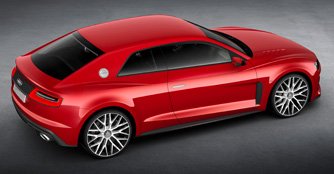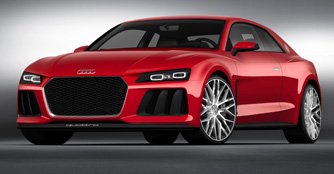Audi to premiere Sport quattro laserlight concept car in Las Vegas
03 Jan 2014|2,584 views
Audi will present a concept car possessing dynamic design, immense power and new electronic features at the Consumer Electronics Show (CES) in Las Vegas, U.S.A. The Audi Sport quattro laserlight concept is reminiscent of the classic Sport quattro of the early eighties, and points towards the future with inclusion of the latest technologies in plug-in hybrid drives, user control and display interfaces and lighting technology.
Finished in 'Plasma Red', the coupe is an evolution of the Sport quattro concept, with dimensions of 4,602mm in length, 1,964mm in width and a height of 1,386mm - with a wheelbase of 2,784mm.
The lower section is nearly vertical, while the upper follows the contour of the hood. Two large, vertical blades divide each of the large air inlets, while the Carbon Fibre Reinforced Polymer (CFRP) constructed splitter are shifted far to the front as on a race car.
Another defining element is the CFRP diffuser at the rear of the car, which extends upward significantly. Its upper section is honeycombed, while its lower section houses two large, oval tailpipes. Taillights are backed by a black CFRP panel while the cargo space of 300 litres is reinforced by a large cross bar stiffener.
The dual headlights demonstrate the future of lighting technology by combining matrix LED and laser light technologies. Two low-profile trapezoidal elements are visible within the headlights - the outer one generates the low beam light using matrix LEDs, while the inner element produces laser light for high-beam functionality.

The plug-in hybrid drive has an output of 700bhp and 800Nm of torque delivered to the quattro drivetrain via a modified eight-speed tiptronic transmission. The show car's combined fuel consumption is just 2.5L/100km - which equates to CO2 emissions of 59g/km.
Located between the engine and the transmission is a disc-shaped electric motor that produces 110kW and 400Nm of torque. It draws its drive energy from a lithium-ion battery at the rear, which stores 14.1kW/h of energy - enough for a range of up to 50km for all-electric driving.
Adding on the figures to the plug-in hybrid Audi is the combustion engine, which is a 4.0-litre V8 biturbo rated for 560bhp of power and 700Nm of torque. The Cylinder on Demand (COD) system deactivates four cylinders under part load and start-stop system aid efficiency.
The driver can switch between three different modes - EV, Hybrid and Sport mode. In Sport mode, the operating strategy configures the drive system for maximum power - which translates to a 3.7 second sprint to the century before hitting a top speed of 305km/h.
A lightweight design strategy plays a major role in the car's dynamic performance. A combination of ultra high-strength steel and cast aluminum is used in the occupant cell, while the doors and fenders are made of aluminum. The roof, engine hood and rear hatch are made of CFRP. This results in an unladen weight of just 1,850kg, including the large battery pack.
Audi will present a concept car possessing dynamic design, immense power and new electronic features at the Consumer Electronics Show (CES) in Las Vegas, U.S.A. The Audi Sport quattro laserlight concept is reminiscent of the classic Sport quattro of the early eighties, and points towards the future with inclusion of the latest technologies in plug-in hybrid drives, user control and display interfaces and lighting technology.
Finished in 'Plasma Red', the coupe is an evolution of the Sport quattro concept, with dimensions of 4,602mm in length, 1,964mm in width and a height of 1,386mm - with a wheelbase of 2,784mm.
The lower section is nearly vertical, while the upper follows the contour of the hood. Two large, vertical blades divide each of the large air inlets, while the Carbon Fibre Reinforced Polymer (CFRP) constructed splitter are shifted far to the front as on a race car.
Another defining element is the CFRP diffuser at the rear of the car, which extends upward significantly. Its upper section is honeycombed, while its lower section houses two large, oval tailpipes. Taillights are backed by a black CFRP panel while the cargo space of 300 litres is reinforced by a large cross bar stiffener.
The dual headlights demonstrate the future of lighting technology by combining matrix LED and laser light technologies. Two low-profile trapezoidal elements are visible within the headlights - the outer one generates the low beam light using matrix LEDs, while the inner element produces laser light for high-beam functionality.
The powerful laser diodes are significantly smaller than LED diodes - measuring only a few microns in diameter. Illuminating the road for a distance of nearly 500 metres, the laser high-beam light has approximately twice the lighting range and three times the luminosity of LED high beam lights. This system that will also be used on the race track with the 2014 R18 e-tron quattro.
The plug-in hybrid drive has an output of 700bhp and 800Nm of torque delivered to the quattro drivetrain via a modified eight-speed tiptronic transmission. The show car's combined fuel consumption is just 2.5L/100km - which equates to CO2 emissions of 59g/km.
Located between the engine and the transmission is a disc-shaped electric motor that produces 110kW and 400Nm of torque. It draws its drive energy from a lithium-ion battery at the rear, which stores 14.1kW/h of energy - enough for a range of up to 50km for all-electric driving.
Adding on the figures to the plug-in hybrid Audi is the combustion engine, which is a 4.0-litre V8 biturbo rated for 560bhp of power and 700Nm of torque. The Cylinder on Demand (COD) system deactivates four cylinders under part load and start-stop system aid efficiency.
The driver can switch between three different modes - EV, Hybrid and Sport mode. In Sport mode, the operating strategy configures the drive system for maximum power - which translates to a 3.7 second sprint to the century before hitting a top speed of 305km/h.
A lightweight design strategy plays a major role in the car's dynamic performance. A combination of ultra high-strength steel and cast aluminum is used in the occupant cell, while the doors and fenders are made of aluminum. The roof, engine hood and rear hatch are made of CFRP. This results in an unladen weight of just 1,850kg, including the large battery pack.
Latest COE Prices
May 2025 | 1st BIDDING
NEXT TENDER: 21 May 2025
CAT A$103,009
CAT B$119,890
CAT C$62,590
CAT E$118,889
View Full Results Thank You For Your Subscription.























